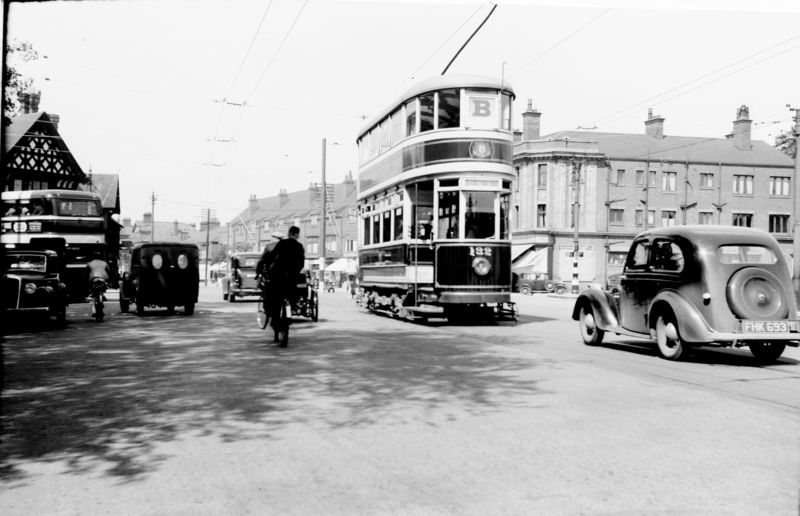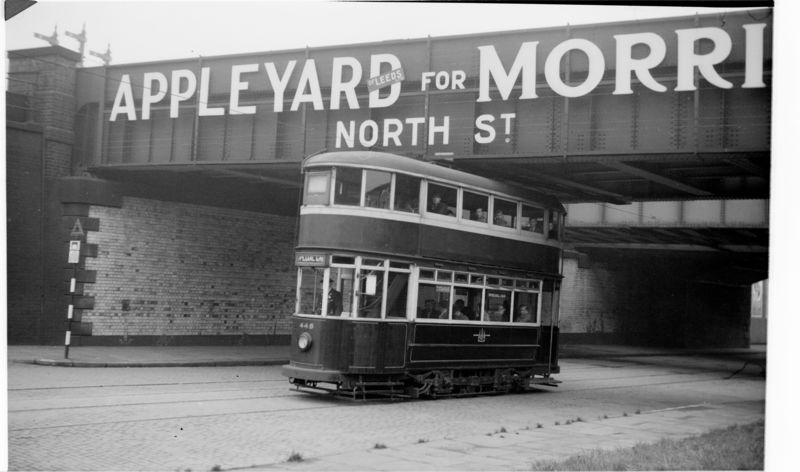Hull City Tramways No. 132

Photo: Jim Dignan. Hull 132 at the Streetlife Museum in Hull
Early electric tramcars in Britain differed from one another in a variety of ways: design of bodywork, degree of protection afforded for passengers and crew, seating (or standing) capacity, livery, the method by which electrical current was conveyed from the power source to the tramcar’s motors and also the gauge of the tracks on which they operated.
Hull 132 reminds us that these differences even extended to the profile of the tram tracks themselves and the manner in which contact was maintained with the tramcar’s wheels. Most tram rail was designed with a flat surface that provided support for the corresponding flat surface of the tram wheel, known as the tyre, and a groove on the inside of the rail which accommodated a narrow flange on the tram wheel that prevented derailment..

Centre-grooved tram rail at Hull’s Streetlife Museum. Jim Dignan, 10/6/2016
Hull City Tramways was one of a small number of early tramcar operators (Doncaster was another) that adopted tram rail with a central groove, which meant that each tramcar wheel also had to have a flange in the centre instead of at the inside edge. As joints in centre-grooved trackwork were cut diagonally instead of at right angles, this had the advantage of making for a much smoother ride than on conventional tram rails.
On the other hand, such an arrangement prevented the through running of tramcars onto any neighbouring system that used a more conventional rail profile and was also inconvenient if tramcars from such systems were later sold onto another operator. As there were no adjoining tramways the through-running issue was not a problem for Hull City Tramways though they did dispose of a number of redundant tramcars (including 132) to other operators, who then had to swap the centre flange wheels for those with a regular profile.
Specification
- Type of tram
- Electric 4-wheel fully enclosed double deck passenger tram (originally built without vestibules and with open balconies with a “Bellamy’ roof)
- Livery
- Maroon and cream
- Seating capacity
- 56 (34 on top deck; 22 downstairs)
- Date built
- 1910
- Manufacturer of body
- Hull Corporation
- Manufacturer of truck
- Peckham P22 (Originally Mountain and Gibson 21 EM). Currently it is mounted (for display purposes) on a Brill 21E accommodation truck.
- Gauge
- 4’ 8½”
- Motor
- 2x DK DB1 K4 40 hp but no longer fitted with these. (Originally Siemens 38 hp)
- Controller
- English Electric DB1 K3B (Originally Siemens Type S)
- Current collector
- Trolley (specially made bow collectors were made for the ex-Hull trams, which were several inches higher than their Leeds counterparts)
- Modification
1931 new top deck fitted and fully enclosed
1933-4 fitted with second-hand trucks together with replacement motors and controllers bought from the Dearne District Light Railways.- Withdrawn from service
1942 transferred to Leeds and renumbered as 446
Withdrawn from service in Leeds in October 1952- Subsequent history
Taken into preservation and worked on in Bolton before being transferred to Crich in May 1960. Transferred to Hull’s Streetlife Museum on long-term loan in March 1983
- Restoration history
Some restoration work undertaken in Bolton before arrival at Crich. Cosmetically restored in its original Hull livery while at Hull during the 1970s.
- Current status
- Restored (though no longer in operational condition) and on display in Hull’s “Streetlife Museum.”
- Current location
- Hull’s “Streetlife Museum”
- 1910 – 1942Operational on original tramway
- 1942 – 1952Operational on a different tramway
- 1952 – 1983In storage and undergoing restoration in various locations
- 1983 –On display in Hull’s Streetlife Museum where it is on long-term loan


